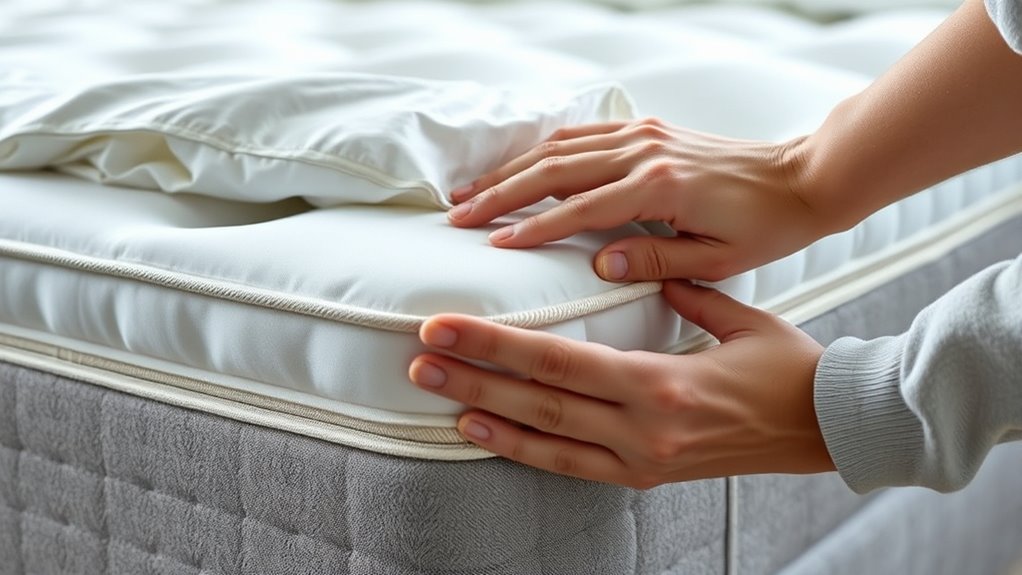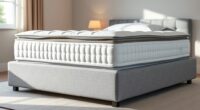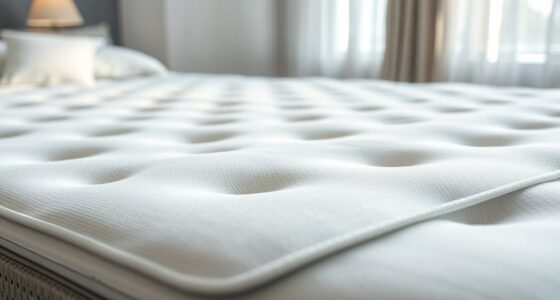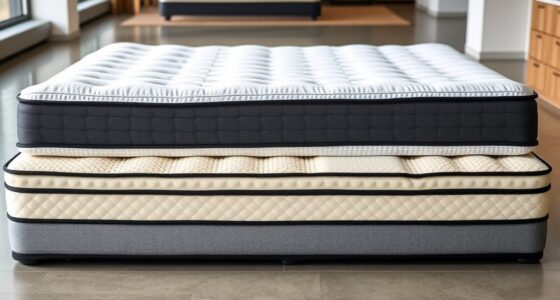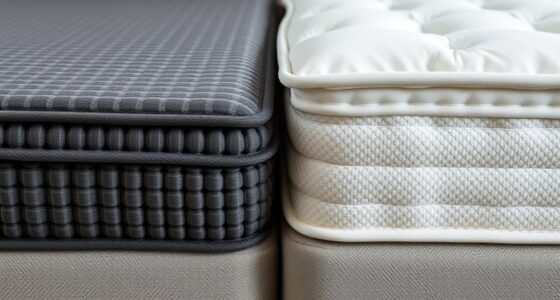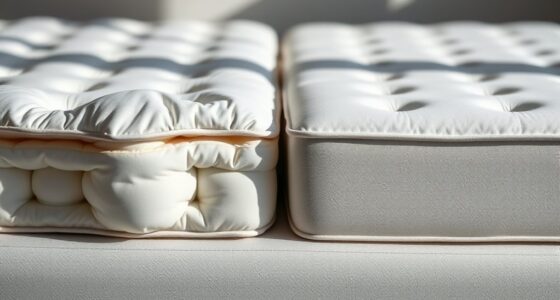Understanding edge support in mattresses is key to ensuring stability, comfort, and durability. It helps prevent sagging or collapsing at the edges, so you can use the full surface without feeling unstable or rolling off. Edge support depends on factors like mattress construction, frame compatibility, and reinforced edges. Knowing how these work together can improve your sleep experience. Keep exploring to discover how choosing the right setup boosts your mattress’s performance even more.
Key Takeaways
- Edge support prevents mattress sagging, maintains shape, and enhances comfort when sleeping near the edges.
- Compatibility with bed frames and slat spacing significantly impacts edge stability.
- Reinforced foam or coil edges improve perimeter support and overall durability.
- Advanced construction techniques and hybrid designs boost edge firmness and support.
- Superior edge support allows full use of the sleeping surface and enhances safety during sitting or sleeping.
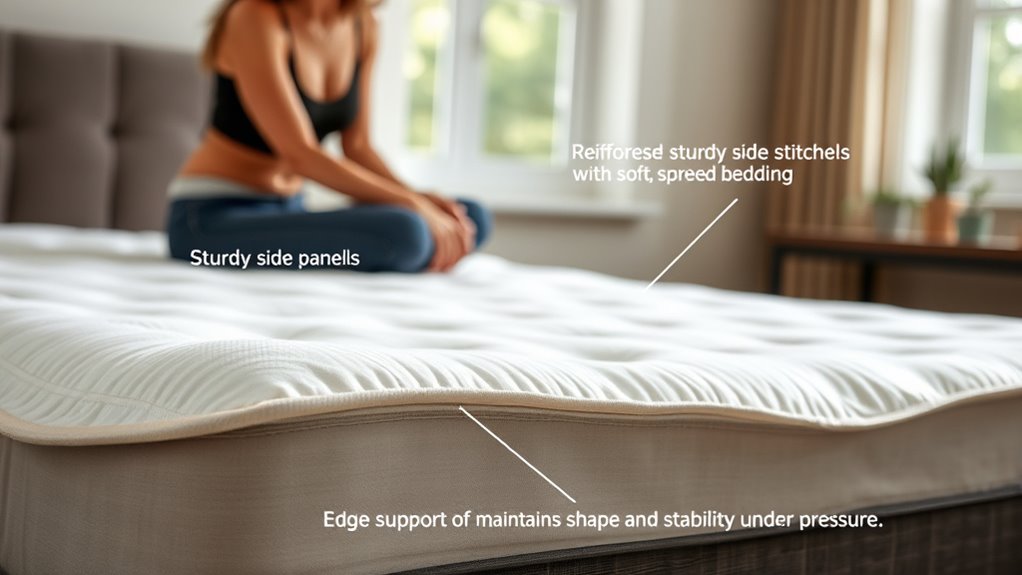
Have you ever noticed how some mattresses feel stable at the edges while others sag or collapse? This difference often comes down to the mattress’s edge support, which plays a vital role in comfort, durability, and usability. When shopping for a new mattress, understanding edge support means considering how well it maintains its shape when you sleep near the sides or sit on the edge. Good edge support prevents that dreaded feeling of rolling off or feeling unstable when you sit close to the edge of your bed.
One key factor influencing edge support is bed frame compatibility. Not all frames work equally well with every mattress, especially when it comes to edge stability. If your bed frame isn’t compatible or isn’t sturdy enough, it can compromise the mattress’s ability to provide proper edge support. For example, some frames may lack the necessary center support or have slats spaced too far apart, leading to compromised edge stability. To maximize your mattress’s edge support, you need a frame that offers solid, consistent support across its entire surface. This includes checking for features like reinforced edges and appropriate slat spacing, which work together to keep the mattress from sagging at the sides.
Edge support technology has advanced considerably in recent years, making it easier to find mattresses that offer superior edge stability. Many manufacturers now incorporate specialized materials or construction techniques designed explicitly to reinforce the perimeter of the mattress. These innovations include reinforced foam edges, high-density coils around the perimeter, or hybrid designs that blend innerspring support with foam encasements. When a mattress features advanced edge support technology, you’ll notice that sitting or sleeping near the edge feels just as firm and supportive as the center. This not only extends the usable sleeping surface but also enhances safety and comfort, especially if you tend to sit on the edge frequently or share your bed with a partner. Additionally, expert voice actors are often used in advertising to convey the importance of such features in a compelling way.
Frequently Asked Questions
How Does Edge Support Affect Overall Mattress Lifespan?
Edge support plays a key role in your mattress’s overall durability and user comfort. When edges are strong, they prevent sagging and reduce wear in those areas, extending the mattress’s lifespan. Without good edge support, you might notice early signs of deterioration, leading to comfort issues and the need for replacement sooner. So, investing in a mattress with solid edge support helps maintain its durability and keeps you comfortable longer.
Can Enhanced Edge Support Improve Sleep Quality?
Enhanced edge support can definitely improve your sleep quality. It helps with bed mobility, making it easier to get in and out of bed without disturbing your sleeping partner. Plus, it reduces mattress sagging at the edges, maintaining comfort and support throughout the night. When your mattress offers solid edge support, you’re less likely to feel unstable or roll off, leading to more restful, uninterrupted sleep.
Does Edge Support Vary Between Different Mattress Materials?
Think of mattress edge support like the sturdy border of a castle. Different materials act as the fortress walls, with foam density and material elasticity shaping their strength. High foam density offers firm, reliable edges, while flexible materials bend but don’t break easily. So, yes, edge support varies between materials—some are like strong stone walls, others like flexible timber—affecting how well your mattress holds up when you sit or sleep near the edges.
Is There a Difference in Edge Support for Foam Versus Innerspring Mattresses?
You’ll notice a difference in edge support between foam and innerspring mattresses. Foam density plays a role; higher-density foams offer better edge support, preventing sagging. Innerspring coils provide solid edge support because the coils run to the edges, giving you stability when sitting or sleeping near the edge. So, if edge support is a priority, consider a mattress with high-density foam or one with reinforced innerspring coils.
How Can I Test Edge Support Before Purchasing a Mattress?
To test edge support before buying, do a bed test by sitting and lying near the edges to see how stable it feels. Perform a firmness check by pressing down on the edges with your hand to see if they sag or stay firm. This helps you gauge if the mattress provides enough support for activities like sitting on the edge or getting in and out of bed comfortably.
Conclusion
Remember, choosing a mattress with strong edge support isn’t just about comfort—it’s about embracing the full potential of your sleep sanctuary. Think of it as the sturdy frame holding a precious gemstone; without it, the beauty and value diminish. So, prioritize edge support to guarantee your mattress remains resilient and supportive, night after night. After all, isn’t the foundation of a good day built on the strength of a good night’s sleep?
